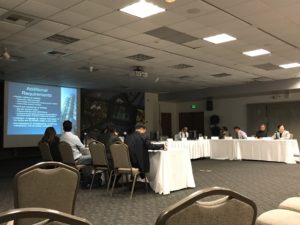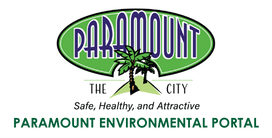 In accordance with its standing plan to meet every fourth Thursday of the month, the Paramount Air Quality Sub Committee held its fifth meeting on Thursday, April 27, 2017. Susan Nakamura from the South Coast Air Quality Management District (SCAQMD) attended the meeting on behalf of the agency and to give a presentation on a few SCAQMD rules.
In accordance with its standing plan to meet every fourth Thursday of the month, the Paramount Air Quality Sub Committee held its fifth meeting on Thursday, April 27, 2017. Susan Nakamura from the South Coast Air Quality Management District (SCAQMD) attended the meeting on behalf of the agency and to give a presentation on a few SCAQMD rules.
Assistant City Manager Kevin Chun first reviewed a few of the questions submitted at the previous Sub Committee meeting. Among those was a request for more information about Aerocraft Heat Treating Company’s newly constructed wall near the SCAQMD air monitor. Mr. Chun clarified that the company is building scaffolding to hold both an Aerocraft monitor and the SCAQMD monitor at the same height in an effort to compare the readings from both monitors. This will also allow Aerocraft to closely monitor their emissions. Aerocraft is in the process of applying for the required permits from the City for this scaffolding, as the moratorium on construction at all metal-related businesses is still in place.
Mr. Chun followed up on the idea of having the metal businesses hold their own Town Hall meetings to address the public. To date, Weber Metals has expressed an interest in the specific plan, while Carlton Forge Works has suggested it may conduct public outreach during the summer. Vice Mayor and Sub Committee member Diane J. Martinez suggested that City staff research conferences that metal businesses attend to find a different approach for the City and the community to reach the industry.
Following the discussion, Assistant Community Development Director John Carver gave an update on the City-owned air quality monitors. All five have been installed as of Friday, April 21. The monitors are located at Wesley Gaines Elementary School, Major Lynn Mokler Elementary School, Abraham Lincoln Elementary School, Promise Hospital, and at Somerset and Vermont near Carlton Forge. Three of these have been co-located with SCAQMD monitors to compare findings. Ms. Nakamura noted that the air district has a multi-metal-detecting monitor situated at the school district headquarters, as well.
On the issue of business licensing, a sample of the City’s new business license application, part of an innovative program devised with SCAQMD, was passed out. The new program will enhance business compliance with SCAQMD rules while ensuring that the agency gains direct and first-hand information about whether or not businesses operating in Paramount need SCAQMD permits. Unlike previously, SCAQMD will now review all business applications submitted to Paramount, then provide guidance to the City if any air quality-related permits are required. If this pilot program is a success, SCAQMD may implement it in other cities.
Mr. Carver gave a presentation on potential non-operational regulations for metal companies in the City. These regulations would apply to properties in the M-1 and M-2 zones. Among proposed regulations are setbacks, buffer landscaping, and business signs. The Sub Committee considered the ideas and requested that the language be expanded to include some non-metal-related businesses, such as companies that work with plastic. Further, Sub Committee members asked to be included in any meetings held between the City and local metal companies. Mr. Chun said he would contact the companies regarding the request.
Consultant Weyman Kam from Tetra Tech gave an air quality update. Mr. Kam described SCAQMD’s enforcement actions to date: the agency has given 28 Notices to Comply and 21 Notices of Violation.
Councilmember Laurie Guillen, attending the meeting as an audience member, asked if the air monitor readings in town could, when combined as one total, create spikes or “hot spots,” even if each individual monitor indicates that readings are in compliance with SCAQMD regulations. Ms. Nakamura explained that, while cumulative impact has been difficult for SCAQMD to quantify, the agency’s scientists and engineers try to take into account what comprises the readings from each air quality monitor. After analysing each reading, SCAQMD reports to the public on which constitute as “hot spots” of the monitored pollutant – in this case, hexavalent chromium – as opposed to sites that have higher readings due to a combination of pollutants.
 Ms. Nakamura then gave a presentation on SCAQMD Rules 1430, 1469, and 1435. The first, Rule 1430, has been successfully implemented and applies to Carlton Forge, Mattco Forge, Press Forge, and Weber Metals. Rule 1430 attempts to reduce toxic and particulate matter emissions, as well as odors, from metal grinding and cutting operations at metal forging facilities. The agency may later review this rule with new requirements for forging. Meanwhile, Rule 1469 applies to Anaplex and other metal facilities that deal with chromium electroplating and chromic acid anodizing. SCAQMD is working on an amendment to this rule so as to better control hexavalent chromium emissions from these types of operations. Lastly, Proposed Rule 1435 addresses the creation of hexavalent chromium emissions from the application of energy and heat to metal parts containing chromium. This rule would apply to Aerocraft and its heat-treating processes, as well as other businesses that undergo similar operations.
Ms. Nakamura then gave a presentation on SCAQMD Rules 1430, 1469, and 1435. The first, Rule 1430, has been successfully implemented and applies to Carlton Forge, Mattco Forge, Press Forge, and Weber Metals. Rule 1430 attempts to reduce toxic and particulate matter emissions, as well as odors, from metal grinding and cutting operations at metal forging facilities. The agency may later review this rule with new requirements for forging. Meanwhile, Rule 1469 applies to Anaplex and other metal facilities that deal with chromium electroplating and chromic acid anodizing. SCAQMD is working on an amendment to this rule so as to better control hexavalent chromium emissions from these types of operations. Lastly, Proposed Rule 1435 addresses the creation of hexavalent chromium emissions from the application of energy and heat to metal parts containing chromium. This rule would apply to Aerocraft and its heat-treating processes, as well as other businesses that undergo similar operations.
Following her presentation, Ms. Nakamura updated the group on the interim compliance measures implemented by Anaplex and Aerocraft and answered questions from the Sub Committee and the audience about SCAQMD’s current processes and how Paramount’s situation compares to other cities. Although Ms. Nakamura was unsure of how many other industries were “watching” Paramount for hints of the air district’s future plans, she indicated that the metal-finishing industry was interested in the unfolding Anaplex story and how it may affect the new rules being created.
The next Air Quality Sub Committee meeting will be on May 25, 2017 at 6:00 p.m.


Comments are closed.